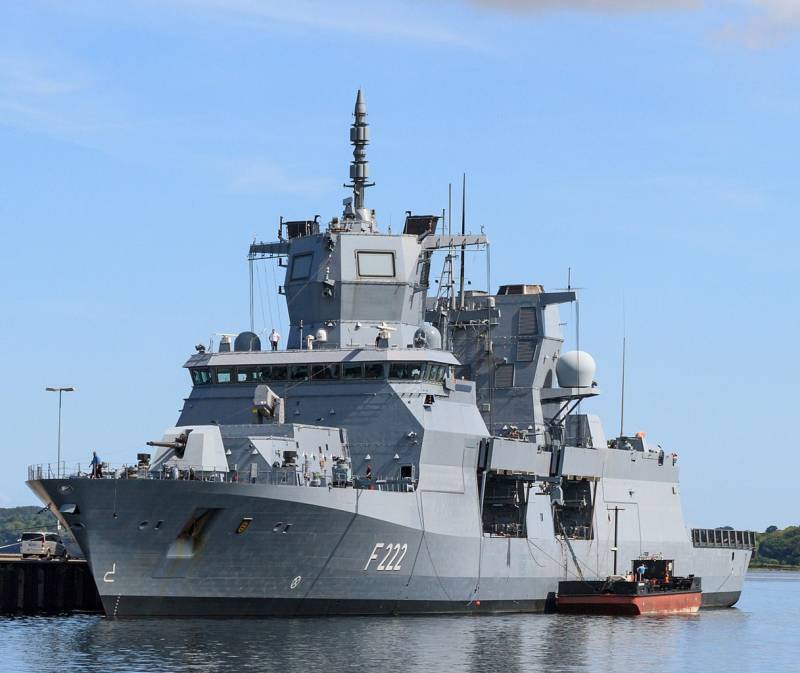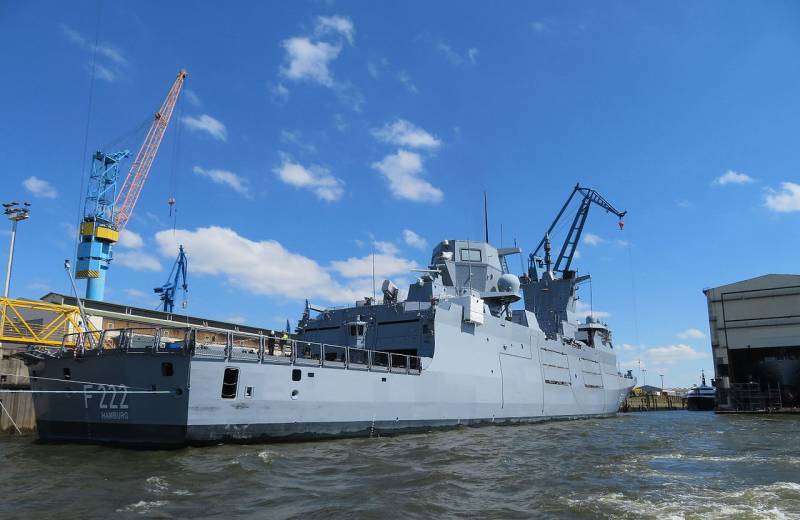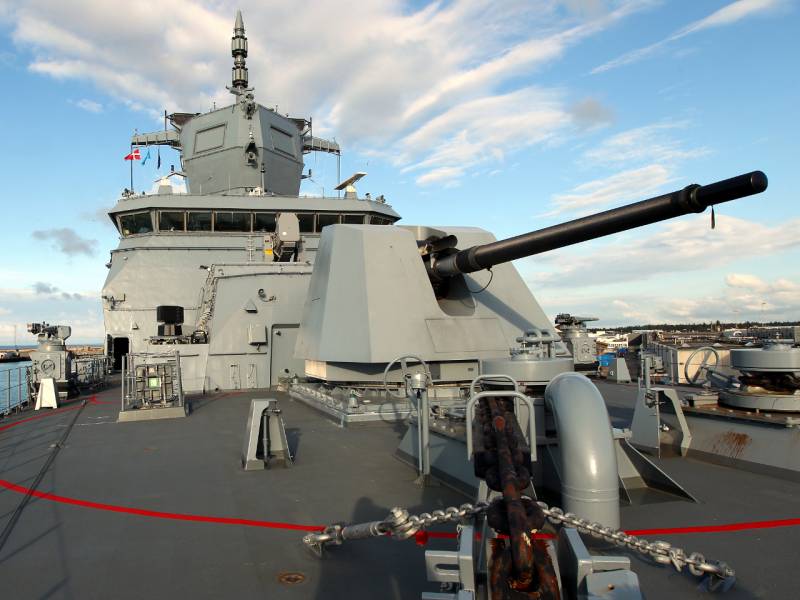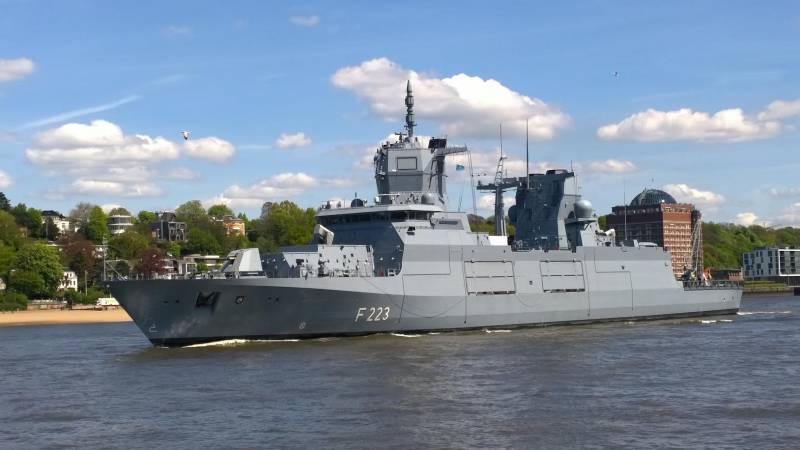Problems of the frigate Baden-Württemberg and the threat to the F125 program
The lead combat ship of the new F125 project - the Baden-Württemberg - was built relatively recently, and at the end of 2016 it was transferred to the German naval forces. Over the next few months, German sailors mastered the frigate and prepared for the start of a full service. In the summer of 2017, it was planned to take him into combat fleet. However, soon the most serious conclusions followed about the unavailability of the ship for normal operation. Already in the spring of last year, it became known that Baden-Württemberg has a number of the most serious drawbacks.
In mid-May, the foreign press, citing a classified report to the command of the German naval forces, announced the discovery of a whole list of serious shortcomings. The main frigate of the new project, F125, turned out to be overweight, which could prevent further upgrades. He had problems with balancing: due to errors in the construction, the ship had a constant roll of 1,3 ° to starboard. The need to carry out these or other work and correct these shortcomings led to the failure of plans. The ship did not reach operational readiness at a previously determined time.
A little later, the media in Germany and other countries reported the presence of other problems. During the tests, it was possible to identify certain shortcomings of electronic equipment and software. In particular, deficiencies interfered with the normal operation of the central post, from which all ship systems are managed.
According to the original schedule, in the first half of last year, the German Navy had to carry out the necessary checks, after which Baden-Württemberg would be able to replenish the fleet combat force and begin full service. However, this did not happen. Improvements, checks and new corrections of deficiencies continued until the end of the year, until the appearance of a new fundamental decision of the command.
In December, it became known that the German admirals were forced to resort to the most serious measures. At that time, the head frigate of the F125 type still had a lot of problems with electronics, onboard systems, design, etc. To resolve this situation, the command decided to return the ship to the plant that built it. It is the shipbuilding company that will now have to carry out all the necessary improvements and repairs, after which the frigate can be returned to the fleet. Previously, the German Navy never returned to shipbuilders an already accepted ship, which shows the exceptional nature of the current situation.
The construction of two F125 projects of the four ordered was carried out by Blohm + Voss (Kiel). Now he, possibly with the participation of other participants in the project, will have to finalize the lead frigate and save him from the identified problems. Apparently, in the future, the plant will have to update the second new frigate, which is already under test. Only after the completion of such work, the naval forces will be able to get the desired series of the newest ships with outstanding characteristics.

Scheme frigate type F125
The development of the project of a promising frigate for the German Navy was carried out by the consortium ARGE F125, which included all the leading shipbuilding enterprises in the country. The creation of a project that meets the modern requirements of the fleet was completed at the turn of the past and the current decades. Already in 2007, a contract for the construction of a series of four frigates appeared. For the supply of the Navy ships were ready to pay 2,2 billion euros. Subsequently, additional funding was needed, and the cost of a single frigate reached 650 million euros.
A promising project of the frigate F125 was developed to replace the aging ships of the type F122 / Bremen. From the beginning of the eighties, the fleet of the Federal Republic of Germany received eight similar frigates with rocket, artillery and torpedo armament. Several years ago, the naval forces began to abandon the frigates of the Bremen project because of their moral and physical obsolescence. From 2014 to 2017, six ships were built from the fleet until the mid-eighties. The newer frigates Augsburg and Lübeck are still in service.
At the beginning of November 2011, the groundbreaking ceremony for the lead ship of the new project, named Baden-Württemberg, took place in Kiel. In October of the following year, the first Nordrhein-Westfalen serial frigate was laid in Bremen. In June, 2014-th in Kiel launched the construction of the third ship of the series Sachsen-Anhalt. The fourth frigate of the type F125, Rheinland-Pfalz, laid in Bremen at the end of January 2015. No further construction was planned - to replace the 6-8 frigates of the Bremen type, it was planned to build only four new ships.
The construction of promising frigates did not encounter serious problems, which made it possible to complete it in accordance with the established schedule. In mid-December, the 2013 of the year launched the headline Baden-Württemberg. In April, the 2015-th launched the first serial "North Rhine-Westphalia". In March 2016, the completion of the Saxony-Anhalt wall began. In May of last year, the fourth frigate of the project, the Rhineland-Palatinate, was launched.
Of the four ships to date, only one has been handed over to the naval forces - the head Baden-Württemberg. The Navy conducted its own tests, during which the most serious shortcomings were identified. To get rid of the existing problems, he was handed over to the shipbuilding plant, which had previously made mistakes. One of the consequences of this is the delay in the delivery of the other three ships. Apparently, the completion and testing of new frigates will have to be suspended indefinitely. When Blohm + Voss and other members of the ARGE F125 consortium can complete the final design of the lead ship, it will be possible to upgrade and improve the remaining frigates, which may have the same drawbacks.
The required work will take some time, due to which the deadlines for the delivery of all four frigates will noticeably shift to the right. In accordance with the original schedule, the head frigate Baden-Württemberg was to join the fleet at the end of 2016. For the summer of 2019, they appointed the acceptance of the last Rheinland-Pfalz. Obviously, now the whole series will be able to pass no earlier than 2020-22. However, the timing of the commencement of the full service of the ships depends primarily on the amount of required modifications and the need to upgrade the second, third and fourth frigates.
Project F125 offers the construction of a relatively large surface ship, capable of solving a wide range of combat missions. The frigates, according to the project, should have a length of about 150 m with a maximum width of 18,8 m and a normal draft of 5 m. Full displacement - 7200 t. The crew includes 110 people, but can be increased to solve special problems. In developing some ideas and solutions were used concerning the reduction of visibility for the means of detecting the enemy, however, in general, ships are not distinguished by an unusual appearance.
A frigate of a new type must be equipped with a power plant of the CODLAG type - a combination of diesel-electric and gas-turbine systems. The use of 4 diesel generators with a power of 2,9 MW, two electric motors with a power of 4,7 MW and 20-megawatt gas turbine engine is envisaged. There is also one bow thruster with an 1 MW engine. With the help of two gearboxes, the power of the electric motors is distributed to the two propeller shaft. The third such unit is responsible for connecting the gas turbine engine.
Using only diesel-electric units, according to calculations, allows the frigate of type F125 to reach speeds up to 20 units. Connecting the gas turbine power plant brings the maximum speed to 26 nodes. Cruising range at optimum fuel consumption is defined in nautical miles 4000.
A new type of ship is equipped with a developed complex of electronic equipment for various purposes. The main means of monitoring and searching for targets are Cassidian TRS-4D and KORA-18 radars. Also provides for the installation of several radar control weapons. There is a hydroacoustic station capable of searching for enemy swimmers. Hydroacoustic equipment to search for submarines is absent. To protect against a possible attack, the frigate can use the optical-electronic and electronic warfare system MASS.
The main percussion means of F125 frigates in the existing configuration are RGM-84 Harpoon anti-ship missiles. Onboard there are launchers for eight such products. It should be noted that the “Harpoon” missiles are considered a temporary solution, since the promising anti-ship missile RBS 15 MK4 is being developed for new German ships. After its appearance, the "Baden-Württemberg" and the ships of the same type will be upgraded with the replacement of the impact missile system.
Missiles can also be used to repel air attacks. The project involves the use of two launchers of RIM-116 RAM Block II missiles with an 21 cell on each.
F125 frigates must carry a developed set of barreled weapons for various purposes. In the bow of the deck mounted artillery installation of the Italian company Otobreda with a gun caliber 127 mm. For the attack of ground targets at ranges up to 100 km, this system can use Vulcano guided missiles. There are several remote-controlled combat module with automatic guns and machine guns. Two MGL 27 modules are equipped with 27-mm automatic cannons. Along the perimeter of the ship are five products Hitrole-HT with large-caliber machine guns. Two more similar machine guns are mounted on thumbnail installations and controlled directly by the shooter.
A curious feature of F125 frigates is the absence of any anti-submarine defense weapons. Ships are not equipped with sonar search systems for submarines, and also do not have weapons for their destruction. For comparison, on the replaced frigates of the project F122 / Bremen there were both hydro-acoustic complexes and torpedo tubes.
In certain situations, the ship may use additional samples of equipment. So, in the rear of the superstructure there is a hangar for two NH-90 helicopters. On the sides of the superstructure there are four paddles for unloading rigid-hull inflatable boats. Also on board the ship there are unskilled underwater vehicles capable of conducting reconnaissance and surveillance.
The proposed set of airborne equipment and weapons allows frigates of the type F125 to search and attack surface, air and ground targets of various kinds. In this case, the customer refused to use ships in anti-submarine defense. As a result, the project provided for the construction of ships with a fairly wide range of tasks to be solved, although with certain limitations.
In accordance with the original plans, in 2016-2019, the German naval forces were to receive four new frigates, named after different lands. They even managed to transfer the lead ship to the fleet and send it to a new stage of testing. As it became known last spring, these checks ended with more than unpleasant conclusions. The main thing is the need to refine the ship in a shipbuilding plant. As a result, the first frigate of the new type, Baden-Württemberg, was returned to the shipyard to perform the necessary work.
For the first time in the history of the German fleet, the built and adopted ship had to be returned to shipbuilders for rework. How long the necessary work will continue is not yet specified. It may take several months or several years to fine-tune the ship. Perhaps in the future you will need a similar restructuring of other ships of the series.
When the Baden-Württemberg returns to service, it is unknown. At the same time, it is now clear that the entire F125 project has faced the most serious problems, and now its future is in question. It is unlikely that the command will decide to completely abandon the four new ships, but the program for their construction is clearly being delayed. It was previously assumed that the fourth frigate of the series will enter service before 2020. Now, after a series of special News, there is every reason to believe that by this date it will not be possible to hand over even the lead ship.
When the consortium ARGE F125 received an order for the construction of new frigates and began construction of the lead fighter, there were eight ships of the F122 / Bremen type in the German Navy. Over the years, the fleet had to write off six such frigates, and the rest could be abandoned in the foreseeable future. The current problems of the new project F125 have already prevented the timely replacement of obsolete ships and can now hit the combat capability of the naval forces. Whether Germany will be able to solve actual problems and get the desired ships that fully comply with the technical requirements, it will be known only in a few years.
On the materials of the sites:
https://navaltoday.com/
http://marine.de/
http://naval-technology.com/
https://wsj.com/




Information